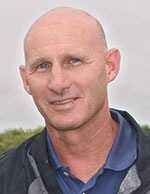The spirit (and soil) of Streamsong
At Streamsong, superintendent Rusty Mercer manipulates sand from a reclaimed phosphate mine to maintain a 36-hole masterpiece.

The 36-hole course at Streamsong Resort boasts a simple theme. There is no signage on the course, no ball washers, no ornamental plantings. Photo by Larry Lambrecht
These 36 holes of golf just don’t belong here.
The views are vast, the dunes are huge. It’s been described as “larger-than-life” and it’s been called “impossible to describe.” Some golfers say it looks like they’re at a course in Africa, others say it looks like it’s in Oregon.
So how strange is it that the Tampa airport is 75 minutes away and Orlando 90? Standing on the first tee of the Red Course at Streamsong Resort is almost disorientating. Who knew Florida was hiding this topography?
It gets better. The site is an old phosphate mine, owned by Mosaic, the world’s largest phosphate and potash producer, and the seventh largest land owner in the state of Florida. The site was already reclaimed — Mosaic needed to do nothing more to the property.
Mosaic decided to go in another direction.
“We realize we have a lot of terrific land,” says Tom Sunnarborg, Mosaic’s vice president of land development and management, and the developer of Streamsong. “But then we also have this land that is… spectacular.”
Eight to 12 million cubic yards of sand had been blowing around here for decades. And then, about three years ago, Mosaic hired the architecture team of Bill Coore/Ben Crenshaw, and Tom Doak, to make a links-style golf paradise in the middle of Florida.
“I remember when Mosaic first called for the proposed course, my thought was, ‘The last thing Florida needs is another golf course,’” Coore laughs. “But they said that this one could be special.”
A sick and twisted beauty
Rusty Mercer, a 30-year superintendent from Mississippi, is the man in charge of maintaining the conditions at Streamsong. Coore, who had worked with Mercer on projects before, called to ask if the Florida project interested him.
Sight unseen, it didn’t. He was happy in Georgia, at another Coore/Crenshaw course, Cuscowilla G&C in Eatonton.
But when he visited the course and saw the landscapes in person, he was sold.
“It’s almost indescribable — it doesn’t look like anything,” Mercer says as he looks out over the course. “There’s enough good golf in Florida, we needed to do something different. My oldest son is a philosophy major. He said, ‘Dad, it’s beautiful, but it’s beautiful in some sort of sick and twisted way.’”
The dirt on Streamsong
Just like the paradox of a sick and twisted beauty, the soil at Streamsong also is a conundrum — half dream, half nightmare.
The result of the phosphate mine is a landscape that consists entirely of sand, 60 to 100 feet deep, for 700 acres. The way Mercer describes it, this is 700 acres of sand in the shape of tiny marbles that won’t compact. It comes perfectly rounded, with zero organic matter.
“We had to plant everything by hand. The sand was so soft we couldn’t put any equipment on it,” Mercer says. “We just started hiring folks and we put them in a big long line and just sprigged them by hand, walking all the way down the fairway.”
That’s a lot of sprigging, considering the course has 165 acres of planted turf. The greens are MiniVerde, the rest of the course is 419 bermudagrass.
But even more interesting than the shifty sand is the lack of organic matter in it. As Sunnarborg says, “You almost can’t call it soil.”
A look at a plug shows what lies beneath: an inch-and-a-half of turf, roots and soil, then sand. Nothing but sand.
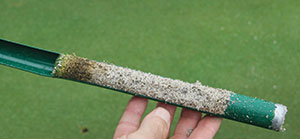
“You always have to take the good with the bad,” Rusty Mercer says of the sandy soil at Streamsong. “Nothing is ever perfect. I’d take this over a situation where things are too wet too often. You can’t get rid of excess moisture in the ground. You can always add a little more water if it’s dry.” Photo by: Seth Jones
“There’s very little organics. What I’m growing this on is not as healthy as it could be. It’s going to take years for us to develop an actual soil,” Mercer says. “Right now we are working with a naked, barren, nothing sand.”
It’s up to Mercer and his first assistant, Rutgers alumnus Kyle Harris, to create a soil. They figure that if they’re tasked with creating it, they might as well create a soil that’s perfect for their needs.
“We can build the soil around what the plant needs to maintain firm and fast — as opposed to having to change both the soil and the plant to achieve firm and fast… which is what you have to do pretty much anywhere else,” Harris says. “I really love that we are building a soil that is suited to what we are trying to do.”
Mercer applies molasses twice a week, as well as chicken manure, 500 pounds an acre in the spring and fall. He says that a lot of what he’s believed his entire career he’s able to put into practice at Streamsong.
“We are building soils. I’m not a big believer in all this new talk on plant health — it’s soil health. Take care of the soil and let the soil take care of the plant,” Mercer says. “That is objective number one. How can we build a better dirt for this plant to survive better in? Everything we do is centered around that.”
It will take time, Mercer and Harris know that. The soil that they have now isn’t much — not even two inches — but it is enough to get them excited. It took a year and a half just to get this much.
“It will take years, but the trick is to break this down into more of a humus material, at the same rate that you’re creating it, or else you have thatch,” Mercer says. “Thatch is no good.”
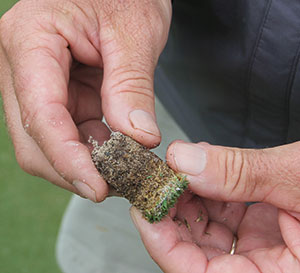
A look at a plug shows what lies beneath: an inch-and-a-half of turf, roots and soil, then sand. Nothing but sand. Photo by Seth Jones
Plays and drains
Mercer isn’t a glass half-full or a glass half-empty type of guy. He sees the good and bad in everything, including his sandy soil. While the shape of the sand and the lack of organic matter are cons, there also are distinct advantages. He loves the way the soil at Streamsong plays, and he loves the way it drains.
Mercer grabs an 8-iron out of the back of his Gator and drops a ball 75 yards from the pin. He bumps the ball, not too hard, and keeps it low. The ball runs and runs, finally stopping a foot from the pin.
“Look at the ball bounce!” Mercer exclaims. “That’s a beautiful thing. That’s because it’s sand. You don’t get that on clay.”
Coore, Crenshaw and Doak hand-picked Mercer because they knew he understood that this is the way they wanted the course to play. Fast, firm.
“We all knew Rusty’s priority was to maintain the golf course to playability as opposed to looks,” Coore tells Golfdom. “He knows the intent (of Streamsong.) Very dry, very firm. Appearance can be important, but it’s not the top priority.”
“Anywhere else you’re fighting sound agronomy and playability. Here they’re the same thing,” Harris says. “We don’t have to make choices between what is sound agronomically and what’s going to compromise playability.”
Mercer drops a ball on the green. “Listen,” he says, demonstrating the green’s firmness. “Hear that? That’s what you want to hear.”
The course drains so quickly, Mercer says, that it could be receiving an inch-and-a-half an hour and the crew could mow during the rain and not cause damage.
“I can’t tell you how many times in Georgia when I’d get an inch-and-a-half of rain and I’d wake up in a cold sweat wondering when we could get out and cut grass,” he laughs. “Not an issue here.”
But if he doesn’t get enough rain?
“Yes, it will get dry. That has to be OK, because playability should come first,” Mercer says. “It’ll turn a little yellow, a little off… it’s not going to die.”
Ball above all
Another beautiful aspect of Streamsong is the simplicity of the course. There are two heights-of-cut on the course: green height, and everything else. There is no maintained rough on the 36 holes.
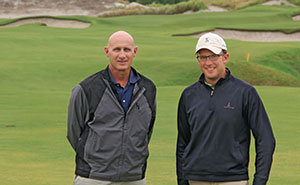
Assistant superintendent Kyle Harris (right) says the best thing about Streamsong is that it makes a golfer feel dwarfed by his surroundings. “The scale is other-worldly. Everyone wants to talk about the dunes, and the elevation changes in Florida. That’s all great, but certain courses around here have similar elevation changes, they’re just not in the tourist areas. It’s the scale.” Photo by Seth Jones
Inside the shop, there are three mowers. A John Deere 8000 cuts everything around the greens and the tees. Deere walking greensmowers with 22-inch fixed heads maintain the greens. A Deere 7500 cuts everything else.
“Real basic, that might be the overriding theme. Which is probably a good idea, the way the business has gone. The cost that is involved now in maintaining a course is just outrageous,” Mercer says. “Just keep it simple, man.”
The simple theme extends beyond the mowers. There is no signage on the course, no ball washers, no ornamental plantings.
“A flagstick is about the only vertical thing you’ll see on the course,” says Sunnarborg. “We’re not anti-ball washer, but it was a conscious decision. It’s a minimalist golf course, and that extends to the resort. We wanted all distractions gone.”
Take a chance
Mercer may be writing the book on how to create his own soil. He doesn’t believe it’s totally unprecedented, saying some accounts of Kiawah describe a similar situation.
He’s received outside help, too. Dick Psolla of Brookside Laboratories has been a longtime consultant for Mercer. Joel Simmons at EarthWorks Natural Organic Products has also been lending a hand, as well as the folks at Harrell’s Fertilizer, including Jeff Higgins.
“The problem is I get a lot of input, but until you’ve actually been on this site and this type of sand and watch it every day, the input isn’t always relevant,” Mercer says. “We’re constantly dry and we hear, ‘Why don’t you go topdress and aerify it back in?’ We can’t aerify because it will get too soft again and then I have to go through the whole process of trying to firm it back up. I don’t even have an aerifier on the property for fear of getting too soft again.”
The work Mercer is doing isn’t lost on his colleagues.
“He’s a magician,” says Scott Wilson, Streamsong’s director of golf. “I don’t know the science but I know he’s always talking about molasses and chicken manure. His passion in his work you can see.”
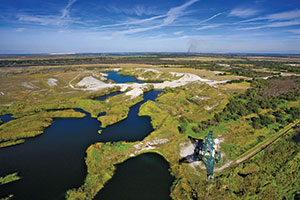
The Streamsong landscape consists entirely of sand, 60 to 100 feet deep, for 700 acres. This shot shows the Streamsong property before the course was developed. Photo by the Mosaic Company
“To grow turfgrass on this sand is not easy,” says Sunnarborg. “What people will find interesting is, (Mercer) has, in the last two-and-a-half years, become an expert on this. He’s going to become very well known, and very sought after.”
For Mercer and Harris, they’re just happy to be involved in such a cool project.
“It’s exciting because you know the result is we have this incredibly firm playing surface that complements the architecture of the course,” says Harris, a golf architecture nut who first arrived at Streamsong as Doak’s intern. “You have Coore at his best, Doak at his best, and we have the ability to highlight that.”
“Here’s a mega-company that didn’t have to do this,” Mercer says of Mosaic. “They put themselves out there, they’re trying to do something for the community at large. You got jobs they’re providing, a tax base that goes up, people are coming here to stay, so money is being spent in areas outside around this.
“The safe thing to do,” he adds, “would have been to keep it being pastures and planting pine trees. I love that they took this chance.”






